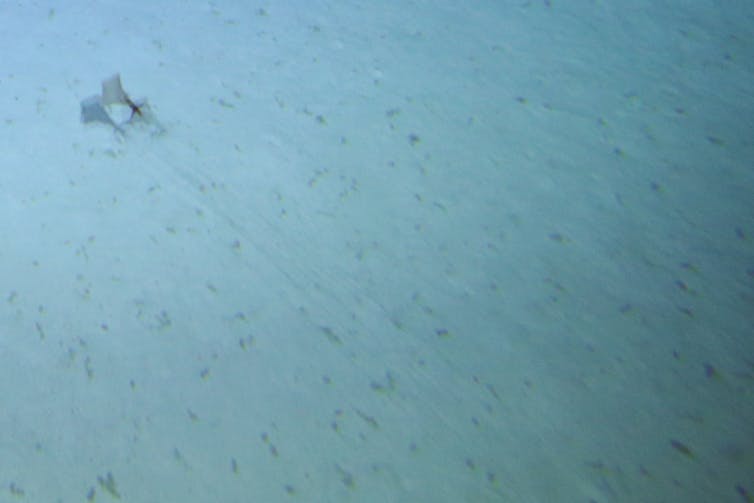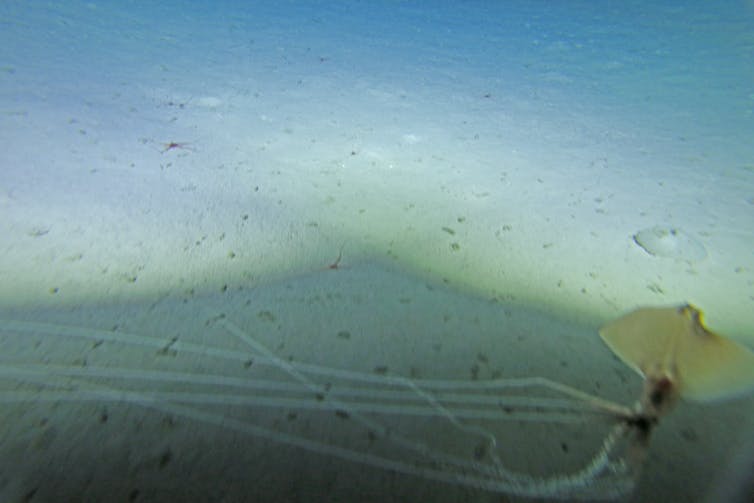This super rare squid is a deep-sea mystery. We recently spotted not 1, but 5, in the Great Australian Bight
- Written by Hugh MacIntosh, Research Associate, Marine Invertebrates, Museums Victoria
The mysterious bigfin squid has been spotted in Australia’s waters for the first time. My colleagues and I from the CSIRO and Museums Victoria detail the encounters in our new research, published today in Public Library of Sciences ONE.
There have only been about a dozen bigfin squid sightings worldwide over the past two decades. Ours happened more than two kilometres below the ocean’s surface in the Great Australian Bight, off the coast of South Australia.
For many people, the phrase “deep-sea squid” may conjure up images of the giant squid, Architeuthis dux, or krakens with huge tentacles swimming in inky black water.
But there are dozens, if not hundreds, of other species of deep-sea squid and octopus (both members of the class Cephalopoda) that are just as mysterious.
First encounters with a slippery individual
For years, one of the only ways to sample the deep sea was to trawl the sea floor with nets. This often damaged the soft bodies of deep-sea organisms beyond recognition. These mangled specimens are then difficult to identify and reveal little to nothing about the creatures.
Fortunately, newer technologies such as remotely-operated vehicles (ROVs) equipped with high-definition cameras are letting scientists see species as they’ve never seen before — offering deeper insight into their shapes, colours and behaviours in the wild.
 Magnapinna is a member of the Cephalopoda class, which includes octopuses and cuttlefish.
Osterhage et al., Author provided
Magnapinna is a member of the Cephalopoda class, which includes octopuses and cuttlefish.
Osterhage et al., Author provided
The enigmatic bigfin squid, Magnapinna, is one case in point. When scientists first described the species in 1998, all they had to go by were some damaged specimens from Hawaii.
The most distinctive feature of these specimens were the large fins (at the very top of the body), which gave the squid its name. Years later, scientists exploring the deep Gulf of Mexico with ROVs realised they had come across Magnapinna in the wild.
They discovered that in addition to its distinctive fins, its arms had incredibly long filaments on the tips, making the bigfin squid unlike any other encountered.
These delicate filaments, which are mostly broken off in collected specimens, give Magnapinna an estimated total length of up to seven meters!
In 2001, scientists exploring the seafloor off Oahu, Hawaii, captured footage of a bigfin squid estimated to be between four and six metres long.Mysterious critters and where to find them
But despite deep-sea ROV surveys becoming more common, Magnapinna has remained elusive.
The handful of sightings have been as far apart as the Central Pacific, North and South Atlantic, Gulf of Mexico and Indian Ocean. This suggests a worldwide distribution.
Yet, the big fin squid had never been seen in Australian waters. That is, until recently, when our team took part in a major research project to better understand the biology and geology of the Great Australian Bight, through the Great Australian Bight Deepwater Marine Program.
On the CSIRO’s research vessel Investigator and charter vessel REM Etive, we surveyed as deep as five kilometres below the water’s surface. Using nets, ROVs and other camera equipment, we recorded hundreds of hours of video footage and uncovered thousands of species.
On one dive, as we watched the video feed from cameras far below us, a wispy shape emerged from the gloom. With large undulating fins, a small torpedo-shaped body and long stringy limbs, it was unmistakably Magnapinna. We yelled and brought the ROV to a halt to get a better look.
The meeting lasted about three minutes. During this time we managed to use parallel laser pointers to measure the squid’s length — about 1.8 meters — before it swam away into darkness.
Read more: Octopuses are super-smart ... but are they conscious?
In total, we recorded five encounters with Magnapinna in the Great Australian Bight. Based on the animals’ measurements, we believe we recorded five different individuals: the most Magnapinna ever filmed in one place.
Most previous records have been of single Magnapinna, but our five squid were all found clustered close to each other. This might mean they like the habitat where they were found, but we’ll need more sightings to be sure.
Unexplained behaviours
The footage we captured has offered new information about Magnapinna’s ecology, behaviour and anatomy.
Previously, Magnapinna has been seen many meters off the sea floor in an upright posture, with arms held wide and filaments draping down. We’re not sure what the specific function of this behaviour is. It might be a way to find prey — akin to dangling sticky, sucker-covered fishing lines.
On our voyage, we saw the squid in a horizontal version of this pose, just centimetres off the sea floor, with its arms and filaments streaming behind. Again, we don’t know whether this behaviour is for travelling, avoiding predators or another method of searching for prey.
 If you look at this photo carefully, you can a bigfin squid with its arms spread wide, and its filaments as faint lines stretching away to the bottom right.
Osterhage et al.
If you look at this photo carefully, you can a bigfin squid with its arms spread wide, and its filaments as faint lines stretching away to the bottom right.
Osterhage et al.
One near-miss with a camera gave us a very closeup image of Magnapinna which showed filaments that appeared to be coiled like springs. This may be a means for Magnapinna to retract its filaments when needed, perhaps if it wanted to avoid damage, or reel in something it caught.
Until now, only one other cephalopod, the vampire squid (Vampyroteuthis infernalis), has been known to coil its filamentous appendages this way.
 A close encounter just centimetres off the seabed shows the squid in a horizontal posture, with its arms spread and filaments dragging behind. Curiously, some of the filaments appear to be coiled like springs.
Osterhage et al.
A close encounter just centimetres off the seabed shows the squid in a horizontal posture, with its arms spread and filaments dragging behind. Curiously, some of the filaments appear to be coiled like springs.
Osterhage et al.
We have learned more about the mysterious bigfin squid. But until we have more sightings, or even an intact specimen, questions will remain.
One thing we do know is ROV surveying has great potential to enhance our understanding of deep-sea animals. With so much of the ocean around Australia yet to be explored, who knows what we’ll see coming out of the gloom next time?
Read more: Curious Kids: have people ever seen a colossal squid?
Authors: Hugh MacIntosh, Research Associate, Marine Invertebrates, Museums Victoria





